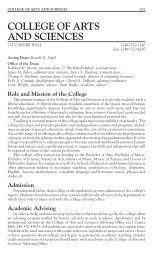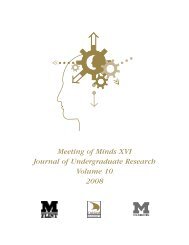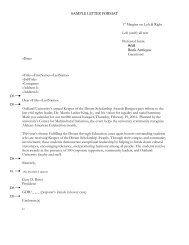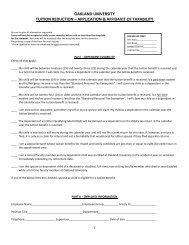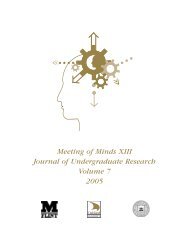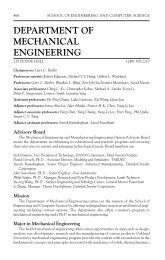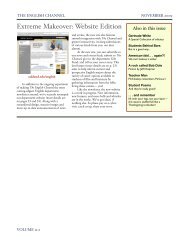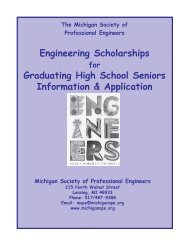MOM 2006 journal for pdf.pmd - University of Michigan-Flint
MOM 2006 journal for pdf.pmd - University of Michigan-Flint
MOM 2006 journal for pdf.pmd - University of Michigan-Flint
You also want an ePaper? Increase the reach of your titles
YUMPU automatically turns print PDFs into web optimized ePapers that Google loves.
ack and read the text (on their own).” The inner-city school students did not do this type <strong>of</strong><br />
activity.<br />
Another activity that the suburban students completed on their own was <strong>of</strong> an arts and crafts<br />
nature. Students were instructed to draw and label the different anatomical features <strong>of</strong> a plant<br />
stem along with their functions. This was the only art activity out <strong>of</strong> a total <strong>of</strong> two that the<br />
suburban students were required to do on their own. All activities that involved drawing or art<br />
were done as a group by the inner-city students.<br />
The inner-city students did most <strong>of</strong> their assignments in groups. They did arts and crafts<br />
assignments, completed worksheets, and drew food webs <strong>of</strong> certain animals—all in groups. The<br />
suburban school students did only one assignment as a group. This was an arts and crafts<br />
assignment in which students were instructed to share each others art supplies to construct their<br />
own three dimensional model <strong>of</strong> a flower.<br />
The first group activity the inner-city students took part in required them to draw everything<br />
they saw in a neighboring field. Students were divided into groups <strong>of</strong> four and an approximately<br />
ten square foot <strong>of</strong> land was assigned to each group <strong>for</strong> observation and drawing. The drawings<br />
were labeled Habitat Maps because students were learning about the types <strong>of</strong> organisms that<br />
inhabited the field. Students worked together as they spotted different organisms in the field, but<br />
each student was required to turn in his or her own drawing.<br />
When students were completing the worksheet identifying insect body parts, they were guided<br />
by the teacher throughout the process. The worksheet was filled out by the class as a group with<br />
the teacher giving the students all the correct answers. At first, she would ask the students <strong>for</strong> the<br />
answer to each blank on the worksheet. However, if none <strong>of</strong> the students raised their hands or<br />
gave an incorrect answer, she would provide the class with the correct response.<br />
The food web assignment required students to draw a food web depicting which animal was<br />
eaten by whom. The teacher asked everyone to listen as she explained how to make a food web.<br />
Be<strong>for</strong>e she began to give her instructions she said, “Listen carefully I’m only going to say this<br />
once.” However, by the end <strong>of</strong> the class period the teacher had repeated the directions a total <strong>of</strong><br />
twelve times and guided the students every step <strong>of</strong> the way. This included giving directions to the<br />
class as a whole and providing instructions and explanations one on one to certain students.<br />
The suburban students did more reading exercises as compared to the inner-city students. This<br />
included reading from the textbook in class and at home. One <strong>of</strong> the reasons the teacher made the<br />
students read out loud in class was the language barrier some students faced. A large number <strong>of</strong><br />
students in the class were <strong>of</strong> Middle Eastern descent. For many the primary language spoken at<br />
home was Arabic. Because the teacher thought these students might not be able to read or<br />
comprehend the material well if they were told to read it on their own, she had the class read as a<br />
group and then she discussed what had been read. She said, “I never assign text material to be<br />
read independently…without going over it in class. Usually we read it together in class first.” She<br />
went on to say that she expects the students to reread the material on their own outside <strong>of</strong> class.<br />
She said, “I always remind my kids that just reading it with me in class is never enough.”<br />
In contrast, the inner-city students were never instructed to read in class. The reason <strong>for</strong> this<br />
could be a lack <strong>of</strong> updated textbooks. The teacher said, “To tell you the truth, the textbooks that<br />
we use here…are ten years old.” The textbooks given to students at this school were published in<br />
Meeting <strong>of</strong> Minds <strong>2006</strong> 2



